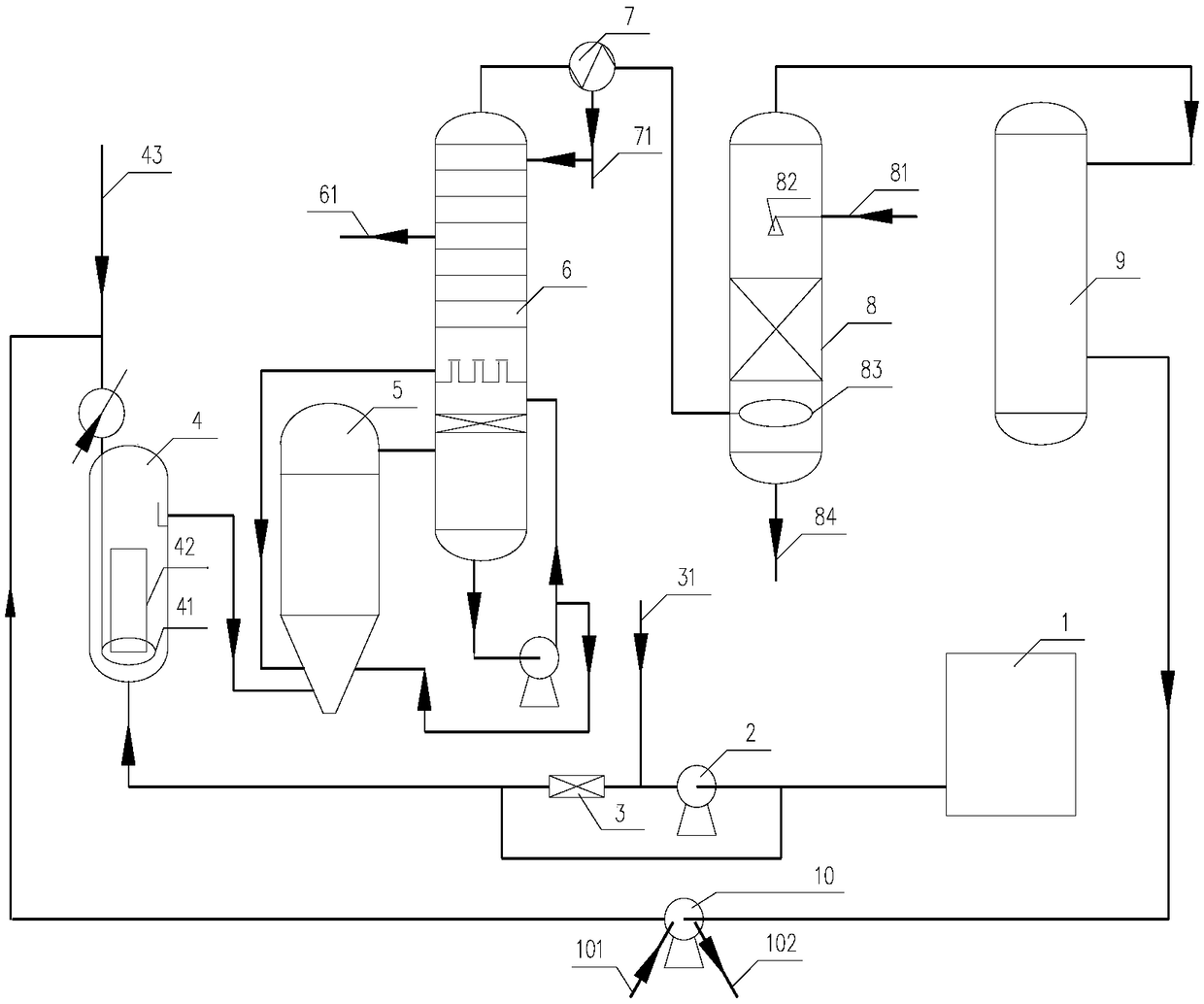Preparation method of adiponitrile and product thereof
A technology of adiponitrile and adipic acid, which is applied in the field of preparation of adiponitrile, can solve problems such as poor mixing effect, influence on operation cycle, and generation of coke, so as to avoid by-products and coke, and reduce production costs , the effect of improving the catalytic performance
- Summary
- Abstract
- Description
- Claims
- Application Information
AI Technical Summary
Problems solved by technology
Method used
Image
Examples
Embodiment 1
[0030] The molten adipic acid with a flow rate of 2400kg / h is sent from the adipic acid buffer tank 1, and the liquid phosphoric acid catalyst of 4.8kg / h is uniformly mixed through the mixer 3 at the outlet of the adipic acid feed pump, and then sent to the ammoniation reaction device 4. The reactor is fed with ammonia gas of 2236kg / h through the ammonia gas inlet 43 (the molar ratio of adipic acid is 8:1, that is, the excess of ammonia gas is 3 times), and the reaction is carried out under the conditions of 160°C and 90KPa, and the adipic acid The acid ammoniation rate is 95%. The ammoniated material enters the nitrilation reactor 5, and is heated to 260°C by steam heating of VP-1 heat transfer oil with good thermal stability and low liquid phase viscosity to generate adiponitrile for dehydration. The reaction will generate by-products such as cyclopentanone and ICCP and intermediate products such as cyanovaleric acid and cyanovaleramide simultaneously. The adiponitrile con...
Embodiment 2
[0033] After flow is the molten adipic acid of 2400kg / h and the liquid phosphoric acid catalyst of 7.2kg / h by the circulation line of mixer and feed pump after uniform mixing, feed the ammonia gas of 2794kg / h (with the mol ratio of adipic acid 10:1, that is, the excess of ammonia is 4 times), wherein the fresh ammonia is about 485kg / h, and the circulating ammonia is about 2309kg / h. Under the condition of 170 DEG C and 90KPa, in the ammoniation reactor 4, the ammoniation rate of adipic acid is 96.5%. The ammoniated material enters the nitrilation reactor, and is dehydrated at 270°C by using VP-1 heat transfer oil steam to generate adiponitrile; the reaction will also generate cyclopentanone, ICCP and other by-products, cyanovaleric acid, cyano Intermediate products such as pentamide. The adiponitrile comprising intermediate product can also continue to enter the lower part of the separation tower for separation, while a part of the circulating liquid is sent back to the bottom...
Embodiment 3
[0035] After flow is the molten adipic acid of 2400kg / h and the liquid ammonium phosphate catalyst of 16.2kg / h by the circulation line of mixer and feed pump after evenly mixing, pass into the ammonia gas of 4471kg / h (with the mole of adipic acid The ratio is 16:1, that is, the excess of ammonia is 7 times) to react, wherein the fresh ammonia is about 776kg / h, and the circulating ammonia is about 3695kg / h. Under the condition of 180 DEG C and 90KPa, in the ammoniation reactor 4, the ammoniation rate of adipic acid is 98.5%. The ammoniated material enters the nitrilation reactor, and is dehydrated at 290°C by using VP-1 heat transfer oil steam to generate adiponitrile; the reaction will also generate cyclopentanone, ICCP and other by-products, cyanovaleric acid, cyano Intermediate products such as pentamide. The adiponitrile containing the intermediate product can also continue to enter the lower part of the separation tower for separation, and the pipeline at the bottom of th...
PUM
 Login to View More
Login to View More Abstract
Description
Claims
Application Information
 Login to View More
Login to View More - R&D
- Intellectual Property
- Life Sciences
- Materials
- Tech Scout
- Unparalleled Data Quality
- Higher Quality Content
- 60% Fewer Hallucinations
Browse by: Latest US Patents, China's latest patents, Technical Efficacy Thesaurus, Application Domain, Technology Topic, Popular Technical Reports.
© 2025 PatSnap. All rights reserved.Legal|Privacy policy|Modern Slavery Act Transparency Statement|Sitemap|About US| Contact US: help@patsnap.com

